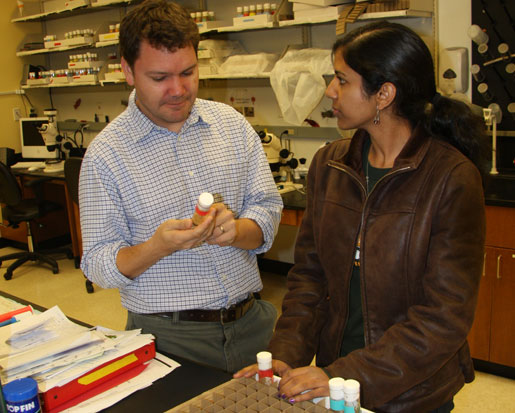Early starter
Mohima Sanyal notches a co-author credit for research she did in high school
When Mohima Sanyal ’14 would drop a transgenic mouse into the lab’s Y-shaped maze, she had a pretty good idea of how the mouse would react. That’s because Sanyal helped create this particular population of transgenic mice, known affectionately in the lab as the “smarties.” The smarties were engineered to recruit a specific protein involved in neural network development at a younger developmental stage than normal mice. Therefore, she explains, infant smarties have the spatial learning and memory capabilities of adults—they are able to navigate and explore the Y-maze like adult mice.
Sanyal did this work even before she enrolled at William & Mary. It was part of her high school senior thesis project, interning at a northern Virginia research lab. Furthermore, she took the project to the Intel Talent Search Regional Finals and was credited as a co-author of “Rules of Engagement: Factors that Regulate Activity-Dependent Synaptic Plasticity During Neural Network Development,” published in the prestigious journal Biological Bulletin.
“Mohima’s accomplishments were outstanding, well beyond those of any high school senior,” commented Theodore Dumas of the Krasnow Institute at George Mason University, Sanyal’s mentor and advisor on the transgenic mouse project.
The main idea of the research focuses on the creation of neural networks. Infants, mice or human, have many more connections and pathways for action potentials—messages pulsated between neurons—than do adults. During neural development, some pathways are solidified and made permanent while other pathways are discarded. With this project, Sanyal investigated the role of a molecule known as the glutamate receptor in neural development. Specifically, Sanyal says she was most interested in how the mice’s developing neural systems switch from protein subunits associated with infant brains to those used by adult animals.
She found the smartie mice recruit the adult subunit earlier and go on to display behavior characteristic of adult mice in the Y-maze. This project is ongoing; more replicates are required to establish the statistical power necessary for significance. Nonetheless, Sanyal suspects the trends she’s observed are real:
“I got to work basically seventy percent of the way through the project,” she said. “We definitely saw the trend that we expected to see, and the research is being continued with other students and researchers that are still in the lab. They seem to be getting positive results from what we expect.”
As a Murrary Scholar at the College of William and Mary, Sanyal will have the opportunity to develop her own interdisciplinary course of study and pursue independent research. She is already involved with research at William & Mary in the cellular and developmental genetics lab of Matthew Wawersik, assistant professor of biology. Sanyal’s interest in neuroscience led her to William & Mary, and the opportunity to pursue an interdisciplinary degree was the selling point.
“Last spring I got to talk with (English Associate) Professor (Anne) Charity Hudley about my interest in neuroscience and her interest in linguistics and the link between the two disciplines,” Sanyal explained. “I was invited to sit in on anthropology courses. I’m thinking of doing an interdisciplinary major with those three subjects—anthropology, linguistics and neuroscience. The fact that I could do something that cool at William & Mary really made it a fit.”
Elizabeth Harbron, associate professor of chemistry and interim director of the Murray Scholars program, said it’s quite rare for a student to be a co-author in a paper published in a peer-reviewed journal.
“A lot of our William & Mary students are involved with research, but even though they’re working really hard and doing great things in the lab, they often don’t make it onto a publication,” Harbron explained. “So, when a student gets to the point where they have work that’s worthy of being on a paper, that’s a really huge thing, no matter where they are in their career. To be able to do that prior to coming to William & Mary is rather unusual. We’ll hope to see Mohima’s name on more papers for her William & Mary research as well.” ![]()















